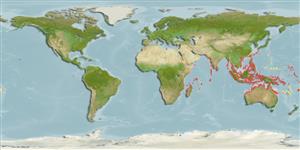Common names from other countries
>
Gobiiformes (Gobies) >
Gobiidae (Gobies) > Gobiinae
Etymology: Valenciennea: From Achille Valenciennes 1794-1865; he worked with Duméril, Cuvier and Lacepède since 1815; malacologist, author of a "Histoire naturelle des poissons" (Ref. 45335).
More on author: Valenciennes.
Environment: milieu / climate zone / depth range / distribution range
Ecologia
marinhas associadas(os) a recifes; intervalo de profundidade 1 - 15 m (Ref. 90102). Tropical; 30°N - 24°S
Indo-West Pacific: widely distributed in the eastern Indian Ocean and western tropical Pacific.
Comprimento de primeira maturação / Tamanho / Peso / Idade
Maturity: Lm 5.4 range ? - ? cm
Max length : 16.0 cm SL macho/indeterminado; (Ref. 48637); idade máx. registrada: 0.75 anos (Ref. 56281)
Espinhos dorsais (total) : 7; Raios dorsais (total) : 12; Espinhos anais: 1; Raios anais : 12. Has 2 to 3 blue-bordered red longitudinal stripes on the head that extends faintly on the body, as well as red basal stripes on the dorsal and anal fins, a dark tip on the first dorsal fin, and red ocelli on the caudal fin; characterized further by pale grey body color on back, grading to white on lower side; without filamentous dorsal spines; rhomboid caudal fin, longer than head; length of caudal fin 2.8-3.5 in SL; longitudinal scale series 73-94; ctenoid body scales, becoming cycloid anteriorly below anterior part of fist of first dorsal fin; head or midline of nape without scales; side of nape with scales extending forward above middle to front of operculum; base of pectoral fin scaleless; usually partly scaled prepelvic area in adult; depth of body 5.1-6.2 in SL (Ref. 90102).
Inhabits shallow coastal sand and rubble flats, often near mangroves (Ref. 48637). Occur in areas of fine sand in shallow lagoon reefs. Adults occur in pairs while juveniles were often seen in small groups. Feed on small invertebrates by sifting mouthfuls of sand. Monogamous (Ref. 52884). Oviparous (Ref. 205). Breeding pairs are commonly found sharing a single burrow (Ref. 56281).
Ciclo de vida ou comportamento de acasalamento
Maturities | Reprodução | Spawnings | Egg(s) | Fecundities | Larvas
Oviparous, distinct pairing during breeding (Ref. 205). Pairs form upon maturation for breeding purposes (Ref. 56281, 58559). Monogamous mating is observed as both obligate and social (Ref. 52884).
Hoese, D.F. and H.K. Larson, 1994. Revision of the Indo-Pacific gobiid fish genus Valenciennea, with descriptions of seven new species. Indo-Pac. Fish. (23):71 p. (Ref. 8527)
Status na Lista Vermelha da UICN (Ref. 130435)
CITES (Ref. 128078)
Not Evaluated
Ameaça para os humanos
Harmless
Uso pelos humanos
Pescarias: espécies comerciais; Aquário: Espécies comerciais
Ferramentas
Relatórios especiais
Baixar XML
Fontes da internet
Estimates based on models
Preferred temperature (Ref.
115969): 25.4 - 29.3, mean 28.6 (based on 2988 cells).
Índice de diversidade filogenética (Ref.
82804): PD
50 = 0.5000 [Uniqueness, from 0.5 = low to 2.0 = high].
Bayesian length-weight: a=0.00661 (0.00397 - 0.01100), b=3.03 (2.89 - 3.17), in cm Total Length, based on LWR estimates for this species & (Sub)family-body (Ref.
93245).
Nível Trófico (Ref.
69278): 3.5 ±0.37 se; based on food items.
Resiliência (Ref.
120179): Elevada, tempo mínimo de duplicação da população menor que 15 meses (Preliminary K or Fecundity.).
Fishing Vulnerability (Ref.
59153): Low vulnerability (10 of 100).
